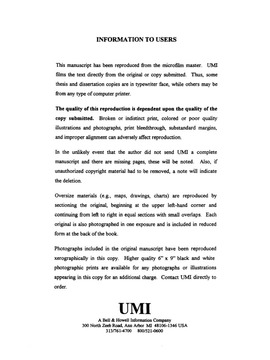| dc.contributor.advisor | VanGundy, Arthur B., | en_US |
| dc.contributor.author | Chung, Intae. | en_US |
| dc.date.accessioned | 2013-08-16T12:30:03Z | |
| dc.date.available | 2013-08-16T12:30:03Z | |
| dc.date.issued | 1998 | en_US |
| dc.identifier.uri | https://hdl.handle.net/11244/5644 | |
| dc.description.abstract | The unit of analysis for this study was the group. Treatment groups A were trained in a modified public relations problem solving (PRPS) process which used CPS techniques as decision making procedures. The treatment groups B were trained in the traditional PRPS process; and the control groups were not trained. | en_US |
| dc.description.abstract | It was concluded that training in CPS activities may have a significant effect on idea quantity and participant satisfaction--at least when public relations campaigns are considered. | en_US |
| dc.description.abstract | Although inter-rater reliability on the quality of ideas was too low to compare the three groups, two judges' ratings were summed for each idea and average quality scores across groups for each condition were compared. This analysis revealed a non-significant effect for the quality of ideas. | en_US |
| dc.description.abstract | The results indicated that there was a significant difference in the quality of the problem statements developed between the three groups. However, a post hoc analysis showed that there was no significant difference in the problem statements produced between groups trained in the modified PRPS process and the traditional PRPS process. The results of the study indicate that groups trained in the modified PRPS process generate significantly more ideas than groups trained in the traditional PRPS and the control groups. | en_US |
| dc.description.abstract | The research question for this study was: What effect does training in techniques of divergent and convergent activities in creative problem solving (CPS) have on public relations problem solving processes? To answer this question, this study focused on the differences between three groups in terms of the quality of problem statements, the quantity of ideas about strategies, the quality of ideas about the strategies, and participants' satisfaction levels. | en_US |
| dc.description.abstract | The study revealed that subjects trained in the modified PRPS process were more satisfied with their perception of freedom to participate and the quantity of ideas generated by their groups than subjects trained in the traditional PRPS. In addition, the results reveal that participants' satisfaction level on "perceived freedom to participate" was positively related to their satisfaction level on the quantity and quality of ideas generated and the process used by them. | en_US |
| dc.description.abstract | The results show that subjects trained in the modified PRPS process were more satisfied with their small group communication than subjects trained in the traditional process. The results show, however, that ideas produced by subjects trained in the traditional PRPS process and in the control groups are significantly better than ideas produced by the subjects trained in the modified PRPS. | en_US |
| dc.description.abstract | The groups were given a hypothetical public relation case. The quality of the problem statements and ideas generated by the groups were evaluated by two judges. The quantity of ideas was measured by counting the number of ideas about the public relations campaign strategies generated by each group of subjects. The satisfaction levels of individuals were measured by participant's self-reports after finishing the experiment task. | en_US |
| dc.format.extent | xxi, 191 leaves ; | en_US |
| dc.subject | Creative thinking. | en_US |
| dc.subject | Mass Communications. | en_US |
| dc.subject | Public relations. | en_US |
| dc.title | Effects of structure on efficacy of public relations problem-solving processes. | en_US |
| dc.type | Thesis | en_US |
| dc.thesis.degree | Ph.D. | en_US |
| dc.thesis.degreeDiscipline | Department of Communication | en_US |
| dc.note | Major Adviser: Arthur B. VanGundy. | en_US |
| dc.note | Source: Dissertation Abstracts International, Volume: 59-04, Section: A, page: 0994. | en_US |
| ou.identifier | (UMI)AAI9828797 | en_US |
| ou.group | College of Arts and Sciences::Department of Communication | |
